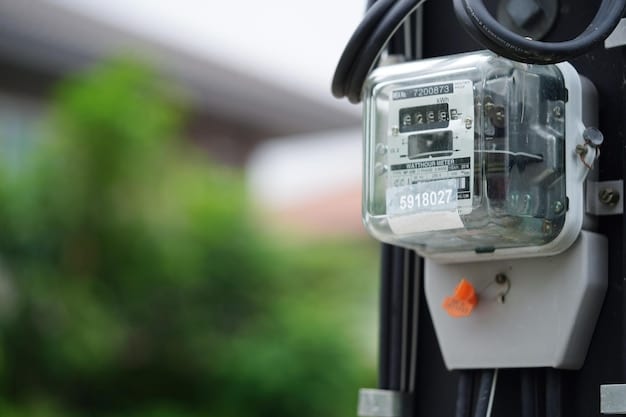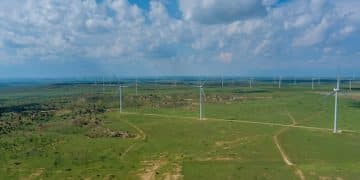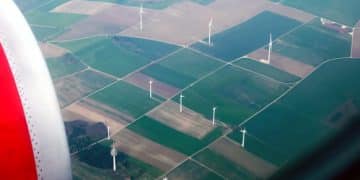Electric Vehicle Demand Impact on US Electricity Grid & Energy Market

The increased demand for electric vehicles (EVs) in the US is poised to significantly reshape the electricity grid and energy market through increased energy consumption, grid modernization needs, and shifts in energy sources and pricing strategies.
The rise of electric vehicles (EVs) is no longer a futuristic concept but a rapidly unfolding reality in the United States. As more and more drivers switch to EVs, the impact on the US electricity grid and energy market will be profound. This article delves into the ways in which this increasing demand will reshape the nation’s energy landscape, examining both the challenges and opportunities that lie ahead.
Understanding the Electric Vehicle Revolution in the US
The electric vehicle market has experienced exponential growth in recent years, driven by technological advancements, environmental concerns, and supportive government policies. Understanding this revolution requires a look at the factors fueling demand and the current state of EV adoption across the United States.
Factors Driving EV Demand
Several factors contribute to the increasing popularity of EVs. These include:
- Environmental Awareness: Consumers are increasingly aware of the environmental impact of traditional gasoline-powered vehicles and are looking for cleaner alternatives.
- Advancements in Technology: Improvements in battery technology have led to longer ranges and faster charging times, making EVs more practical for everyday use.
- Government Incentives: Federal, state, and local incentives, such as tax credits and rebates, help to reduce the upfront cost of purchasing an EV.
Current State of EV Adoption
EV adoption varies significantly across different regions of the US. States with strong environmental policies and robust charging infrastructure, such as California, lead the way. However, EV sales are increasing nationwide as infrastructure expands and consumer awareness grows.
The surge in EV adoption signals a major shift in the transportation sector, directly impacting the demand for electricity and necessitating significant adjustments to the existing energy infrastructure. The potential for EVs to reduce emissions and improve air quality is substantial, but realizing these benefits requires strategic planning and investment in grid modernization.

The Immediate Impact on Electricity Demand
The most immediate effect of increased EV adoption is a rise in electricity demand. This surge poses both challenges and opportunities for the US electricity grid. Understanding the scale of this demand is crucial for effective planning and grid management.
Projecting Future Electricity Needs
Estimating the additional electricity required to power a growing EV fleet is complex. Factors such as the number of EVs on the road, average miles driven per vehicle, and charging patterns all influence the total demand. Experts predict a significant increase in electricity consumption as EVs become more common.
Strain on Existing Infrastructure
The current electricity grid in many parts of the US is not equipped to handle a significant increase in demand. Overloaded transformers, aging power lines, and limited grid capacity can lead to brownouts and blackouts, especially during peak demand periods.
Addressing these challenges requires substantial investment in grid modernization, including upgrading infrastructure, implementing smart grid technologies, and improving energy storage capabilities. Failing to do so could hinder the widespread adoption of EVs and undermine their environmental benefits.
The immediate impact on electricity demand is a critical consideration. Proactive measures are essential to ensure the grid can support the EV revolution without compromising reliability or affordability.
Grid Modernization and Infrastructure Development
Modernizing the electricity grid is essential to accommodate the increasing demand from electric vehicles. This involves upgrading existing infrastructure, implementing smart grid technologies, and expanding charging infrastructure.
Upgrading Existing Infrastructure
Many components of the current electricity grid are outdated and cannot handle the increased load from EVs. Upgrading these components is crucial for maintaining reliability and preventing outages. This includes:
- Replacing aging transformers and power lines.
- Increasing the capacity of substations.
- Improving grid resilience to extreme weather events.
Implementing Smart Grid Technologies
Smart grid technologies can help optimize energy distribution and manage demand more efficiently. These technologies include:
Smart grids provide real-time data on energy consumption and grid conditions, allowing utilities to respond quickly to changing demand. This can help prevent overloads and improve overall grid stability.
- Smart meters that provide real-time data on energy consumption.
- Advanced sensors that monitor grid conditions.
- Automated control systems that optimize energy distribution.
Expanding Charging Infrastructure
A robust and accessible charging infrastructure is essential for supporting EV adoption. This includes:
- Public charging stations in convenient locations.
- Home charging solutions for EV owners.
- Workplace charging programs to encourage EV adoption among employees.
Investing in grid modernization and charging infrastructure is critical for enabling the widespread adoption of EVs and ensuring a reliable and sustainable energy future.
The Role of Renewable Energy Sources
Integrating renewable energy sources is crucial for maximizing the environmental benefits of electric vehicles. By powering EVs with clean energy, we can further reduce greenhouse gas emissions and create a more sustainable transportation system.
Combining EVs with Solar and Wind Power
Solar and wind power are two of the most promising renewable energy sources for powering EVs. These technologies can provide clean, abundant electricity to charge EVs, reducing their carbon footprint even further.

Benefits of Renewable Integration
Integrating renewable energy sources with EVs offers numerous benefits, including:
By combining EVs with renewable energy, we can significantly reduce our reliance on fossil fuels and create a cleaner, more sustainable energy system.
- Reduced greenhouse gas emissions.
- Improved air quality.
- Increased energy independence.
The integration of renewable energy sources is a key component of a sustainable EV ecosystem. It ensures that the environmental benefits of EVs are fully realized, contributing to a cleaner and healthier future.
Impact on the Energy Market and Pricing Strategies
The rise of electric vehicles is poised to significantly impact the energy market and pricing strategies. Utilities and energy providers are exploring innovative approaches to manage EV charging demand and ensure grid stability while offering competitive pricing options.
Time-of-Use Pricing
One popular strategy is time-of-use (TOU) pricing, which charges different rates for electricity depending on the time of day. This can incentivize EV owners to charge their vehicles during off-peak hours, reducing strain on the grid during peak demand periods.
Demand Response Programs
These programs offer incentives for EV owners to reduce their electricity consumption during peak demand periods. Participants may receive rebates or credits for shifting their charging times or reducing their overall energy usage.
Utilities are also exploring dynamic pricing models that adjust electricity rates based on real-time grid conditions. These models can help balance supply and demand, ensuring a stable and reliable energy supply.
New Business Models for Energy Providers
The EV revolution is creating new opportunities for energy providers. Some companies are offering bundled packages that include EV charging, renewable energy, and home energy management services. These innovative business models can help attract and retain EV customers while promoting sustainable energy practices.
The impact on the energy market is multifaceted. As the demand for electricity increases, so does the need for sophisticated pricing and management strategies. These strategies are crucial for maintaining grid stability and encouraging efficient energy use.
Challenges and Opportunities in the EV Transition
The transition to electric vehicles presents both challenges and opportunities for the US electricity grid and energy market. Overcoming these challenges and capitalizing on the opportunities are essential for a successful and sustainable EV future.
Challenges
One of the biggest challenges is the need for significant investment in grid modernization and charging infrastructure. Building a robust and reliable charging network requires cooperation between government, utilities, and private companies.
Another challenge is managing the increased electricity demand from EVs. This requires careful planning and strategic investment in renewable energy sources and smart grid technologies.
Ensuring equitable access to EV charging is also a key concern. Efforts must be made to ensure that EV charging is accessible to all communities, regardless of income level or geographic location.
Opportunities
The EV transition also presents numerous opportunities for innovation and economic growth. The development of new charging technologies, battery storage solutions, and smart grid applications can create jobs and drive economic development.
The transition to EVs can also improve air quality and reduce greenhouse gas emissions, leading to a healthier and more sustainable environment.
The rise of EVs can also increase energy independence by reducing our reliance on foreign oil and promoting the use of domestic renewable energy sources.
The journey toward widespread EV adoption is complex, but the potential benefits are immense. By addressing the challenges and seizing the opportunities, the US can pave the way for a cleaner and more sustainable transportation future.
| Key Aspect | Brief Description |
|---|---|
| 🚗 EV Demand | Rising EV sales increase electricity demand substantially nationwide. |
| ⚡ Grid Modernization | Upgrading infrastructure and smart tech enhances grid capacity & stability. |
| ☀️ Renewable Energy | Integrating solar & wind powers EVs, reducing emissions further. |
| 💰 Pricing Strategies | Time-of-use rates & demand response programs balance supply and demand. |
FAQ
▼
Increased EV demand may lead to higher electricity bills for all consumers if the grid isn’t upgraded efficiently. Time-of-use pricing can help mitigate this by incentivizing off-peak charging.
▼
Using renewable energy to power EVs significantly reduces greenhouse gas emissions, improves air quality, and promotes energy independence, creating a more sustainable transportation system.
▼
A smart grid uses real-time data and automated controls to optimize energy distribution, helping manage EV charging demand, prevent overloads, and improve overall grid stability.
▼
Consumers can benefit from federal and state tax credits, rebates, and other incentives that lower the upfront cost of purchasing an EV, making them more accessible.
▼
Utilities can implement time-of-use pricing, offering lower rates for electricity during off-peak hours, incentivizing EV owners to charge their vehicles at night and reduce grid strain.
Conclusion
The increasing demand for electric vehicles is set to reshape the US electricity grid and energy market in significant ways. While challenges exist, such as the need for substantial investments in infrastructure and the management of increased electricity demand, the opportunities for creating a more sustainable, efficient, and environmentally friendly energy future are immense. By embracing innovation, implementing smart grid technologies, and integrating renewable energy sources, the US can successfully navigate this transition and unlock the full potential of electric vehicles.





